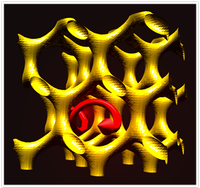Creating new optical properties from self-stacking nanostructures
So what is a Metamaterial?!
Metamaterials are artificial materials engineered to have properties not readily available in nature. These materials gain their properties from structure rather than composition. Potential applications of optical metamaterials include superlenses and cloaking devices that hide their contents, unachievable with normal materials.
In my work nanostructured materials are created by the “auto-assembly” of a particular architecture, called a gyroid, that when replicated in gold produces novel optical properties such as enhanced light transmission.
This structure is fabricated with a feature size below 10 nm, the smallest three dimensional metamaterial ever made.

Left: The fabrication process replicating the gyroid block copolymer structure into gold. Right: Scanning Electron Microscopy (SEM) image of the final gold metamaterial.
How is it made?
The fabrication starts with block copolymer self-assembly that forms two separate intricate networks made of different polymers in the gyroidal structure below and embedded in a third polymer (a). After selective removal of one gyroid network (b) the resulting porous network is backfilled with gold by electrodeposition from a conducting substrate (c). The remaining polymers are then removed giving the gold nanostructured gyroid (d).
Why the gyroid?
The gyroid is an intriguing structure with a chiral three dimensional network and a zero mean curvature at every point (all curves bend both ways). Its chirality has been predicted to lead to a negative refractive index, a milestone in metamaterials research, because it allows very unconventional optics to occur.
The optical properties (the jargon part)
The ordered and continuous nanostructured gyroid network results in a reduction of the plasma frequency of gold (we call it “holey gold”) and to the transport of the optical energy through the strut network by coupled plasmon resonances, leading to high transmission (~30% though a 300nm thick gold gyroid film, several orders of magnitude larger than if the same materials are squished flat).
What else
Recently I demonstrated how these new optical properties can also be tailored with fine control of the structural dimensions. Changes in gyroid dimension, filling fraction and the surrounding medium enable different tuning mechanisms and optical properties[i].
Further studies are focused on fabrication of stretchable gyroid metamaterials and to a more complex gyroid-like structure with even higher light transmittivity.
NanoDTC PhD Student Cohort 2009
http://steiner.bss.phy.cam.ac.uk/ S. Vignolini et al. Adv. Mater. 2012 , 24 , OP23 -27
S. Salvatore et al. Adv. Mater. 2013, 25, 2713-2716

